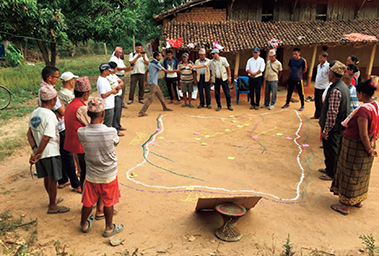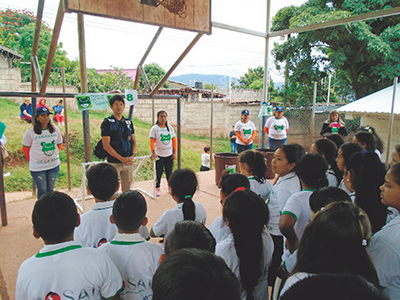(7) Mainstreaming of Disaster Risk Reduction, Measures of Disaster Risk Reduction, and Post-Disaster Recovery and Creating Sustainable Cities
In developing countries that are vulnerable to disasters, the poor are more likely to be affected significantly and displaced by disasters. In addition, protracted secondary damage, such as the deterioration of sanitary conditions and food shortages, can increase the severity of the issue and have a significant impact on the entire society and economy in developing countries. Therefore, it is necessary to build a disaster-resilient and flexible society to protect human lives from disasters. At the same time, efforts aimed at sustainable development are needed. Among them, it is important to promote the “mainstreaming of disaster risk reduction” that introduces the perspective of disaster risk reduction in all the development policies and plans.
Moreover, in recent years, attention has been focused on the various issues relating to the management of cities, which serve as primary settlement areas of humans and are the focal points of economic, social, and political activities. For example, such issues include measures to handle the disposal of the substantial amount of waste emitted in urban areas and suburbs, prevention of air, water, and other pollution, development of infrastructure facilities including sewage and waste treatment systems, and responses to rapid population increases and the consequent rapid pace of urbanization. Addressing these issues and engaging in efforts to realize sustainable cities have become priorities for development cooperation.
Thus, among the SDGs, Goal 11 sets forth the following task: “Make cities and human settlements inclusive, safe, resilient and sustainable.” Likewise, there is growing international interest in resolving the issues of human settlements, including realizing sustainable cities.
NepalPublic nomination
Disaster Risk Reduction (DRR) Strengthening Project in
Chitwan District (Phase 1 and 2)
Grant Assistance for Japanese NGO Projects (November 2017 – November 2019)

Local residents drawing a map on the ground to identify flood-prone areas and safe areas in the community in order to make a hazard map (Photo: SHAPLA NEER = Citizens’ Committee in Japan for Overseas Support)
In Madi, Chitwan District, located on the plains of southern Nepal, there are several large and small rivers flowing from south to north that would frequently overflow every year during the rainy season, causing flood damage to fields and houses. In response, SHAPLA NEER = Citizens’ Committee in Japan for Overseas Support, a Japanese non-profit organization, implemented a project to reduce the disaster risk of entire rivers based on the concept of “One River One Community,” broad-area watershed management that works on flood countermeasures spanning from upstream to downstream. Started as a self-funded project in 2016 covering eight villages near the Bandarmudhe River in Madi, SHAPLA NEER has been implementing the disaster risk reduction project for three years from 2017 through the Grant Assistance for Japanese NGO Projects.
As a direct measure to reduce flood risk, infrastructure construction works were carried out based on surveys and technical guidance by Japanese experts in landslide and flood prevention techniques, such as widening the river to build earthen embankments and constructing revetments with gabions, boxes, or cages filled with rocks, in dangerous areas with flood risk. In addition, in the Bandarmudhe River Basin, the project encouraged local people to form community disaster risk reduction committees, and through regular meetings of these committees, developed disaster risk reduction maps (hazard maps) for each village. Moreover, the project worked to raise awareness of disaster risk reduction among local residents by providing them with hand crank sirens to warn their communities in case of heavy rain.
As a result, no floods have been reported in the target area even after three rainy seasons since the project started. In addition, local residents are now able to act in advance to prevent disasters, for instance by using sirens to warn downstream communities of danger from upstream communities. Prior to this, they used to evacuate just before or even after the river had overflowed. Furthermore, Madi City Council highly praised these initiatives and allocated a budget for flood prevention measures. This shows that the SHAPLA NEER initiative has become sustainable, promoting self-reliant growth in line with the basic principle of Japan’s ODA.
●Japan’s Efforts
... Cooperation in Disaster Risk Reduction

A disaster risk reduction training by a JICA expert in Honduras (Photo: JICA)
Japan utilizes its enriched knowledge and technology acquired through its past experiences with natural disasters, such as earthquakes and typhoons, to provide proactive support for disaster risk reduction and post-disaster recovery measures, alongside emergency assistance. In 2015, as a result of the Third UN World Conference on Disaster Risk Reduction held in Sendai City, the Sendai Framework for Disaster Risk Reduction 2015-2030 (Sendai Framework) was adopted. The Sendai Framework incorporated ideas proposed by Japan, such as the “mainstreaming of disaster risk reduction,” the importance of investment in disaster risk reduction, the commitments of diverse stakeholders, the concept of “Build Back
Better,” and the importance of women’s leadership.
Furthermore, then Prime Minister Abe announced the Sendai Cooperation Initiative for Disaster Risk Reduction Phase 2 in 2019 as a new support initiative that would become Japan’s future basic policy for cooperation in the field of disaster risk reduction. Japan demonstrated its attitude to further contribute to the international community by utilizing its advanced expertise and technology in the field of disaster risk reduction. Specifically, in addition to providing support for at least five million people over the four-year period from 2019 to 2022 for flood countermeasures and other measures, Japan also announced human resources development for a total of 48,000 officials and local leaders and disaster risk reduction education for a total of 37,000 children who will create the next generation. Such efforts by Japan enhanced not only the quality of building structures and improvement of disaster monitoring facilities in each country, but also the development of human resources in fields such as laws and plans enactment related to disaster risk reduction, formulation of disaster risk reduction policies, and disaster monitoring. Consequently, the mainstreaming of disaster risk reduction is progressing in each country.
In addition, at then Prime Minister Abe’s encouragement at the UN General Assembly in December 2015, a resolution was adopted to establish November 5 as World Tsunami Awareness Day in order to raise awareness of tsunamis. Accordingly, the “High School Students Summit on World Tsunami Awareness Day 2019 in Hokkaido” was held in Sapporo in September 2019 and the “Third World Tsunami Museum Conference” was held online in November 2020.
Moreover, Japan is providing disaster risk reduction cooperation through international organizations. For example, in close cooperation with UNDP, Japan is implementing projects including the formulation of tsunami evacuation plans and tsunami evacuation drills for countries at high tsunami risk in the Asia-Pacific region. Based on World Tsunami Awareness Day, phase I of the project provided support from a practical local perspective for raising awareness on tsunami disaster risk reduction and strengthening disaster risk reduction capabilities and systems in each country. The project was implemented from June 2017 to November 2018 aimed at helping community residents including children in areas vulnerable to tsunamis to learn how to prepare for tsunamis and how to act when a natural disaster occurs. Under the project, tsunami disaster management plans were formulated and updated, and programs for tsunami education were implemented at a total of 115 schools across 18 target countries with 61,175 people participating in evacuation drills. The Regional Guide for Schools to Prepare for Tsunamis was also developed and used. Under phase II Note 43 of the project, which began in December 2018 based on this experience and with a target period through July 2020, the institutionalization of disaster risk reduction has been promoted in Palau, with a Presidential Proclamation declaring September as National Preparedness Month. Also, teacher and other staff trainings were conducted at 136 schools, and the formulation and revision of tsunami disaster management plans as well as programs for tsunami education were implemented at 202 schools across 11 countries, with 88,841 students, teachers, and other school personnel participating in tsunami evacuation drills.
Additionally, Japan also cooperates with the United Nations Institute for Training and Research (UNITAR). Every year since 2016, the UNITAR Hiroshima Office has implemented a human resources development project (lectures, study tours to domestic disaster-affected areas, etc.) related to women’s roles and leadership during times of natural disasters, particularly in the event of tsunamis, targeting female government officials and others in developing countries vulnerable to natural disasters, with the aim to spread and raise awareness of World Tsunami Awareness Day. Through this project, 123 people have participated from 18 Pacific and Indian Ocean island countries by the end of 2019.
... Realizing Sustainable Cities
Based on the Development Cooperation Charter, Japan implements initiatives to resolve global issues directly related to human settlements, including efforts for promoting disaster risk reduction, recovery from natural disasters, and a sound water cycle. In particular, drawing on its know-how and experience, Japan develops infrastructure, including water and sewage, waste, and energy facilities. In addition, Japan carries out disaster risk reduction programs, human resources development, etc. based on the concept of “Build Back Better,” striving to build cities that are more resilient to natural disasters after rebuilding. Furthermore, Japan implements initiatives through providing assistance to the United Nations Human Settlements Programme (UN-Habitat), which promotes sustainable urban development. One example can be seen in Japan’s collaboration with the UN-Habitat Regional Office for Asia and the Pacific (ROAP), based in Fukuoka, to introduce the environmental technology of private-sector companies and local governments in Japan to their overseas counterparts.
- Note 43: Targeting 18 countries in the Asia-Pacific region (5 of which are newly added).
